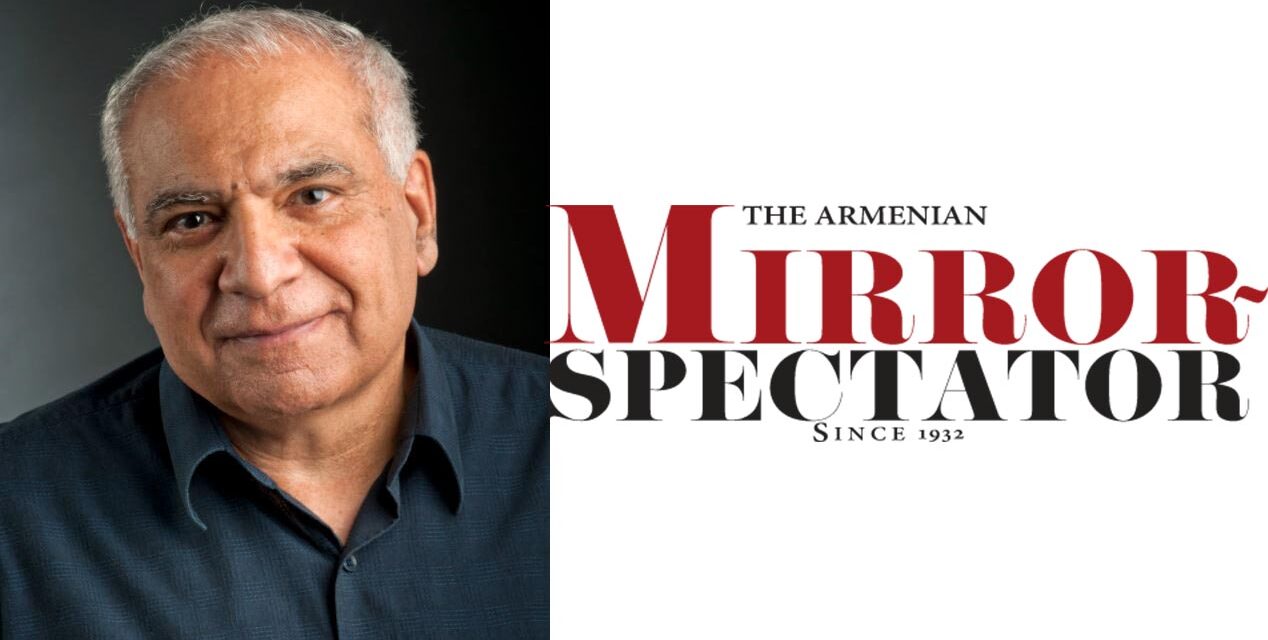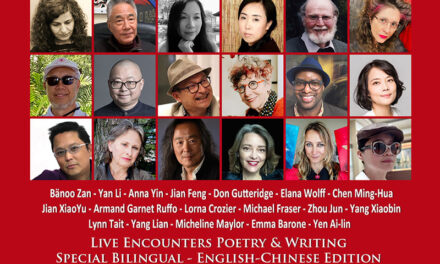Link to the Article originally published to The Armenian Mirror Spectator
YEREVAN / MISSISSAUGA (Ontario, Canada) – Keith Garebian, born in 1943 in Bombay, India, is a widely published, award-winning author, poet, biographer, and literary, dance and theatre critic. He has lived in Canada since 1961. He studied English at Sir George Williams University, Montreal (M.A.) and Queen’s University, Kingston (Ph.D.), after which he taught part-time at McGill, Concordia and Trent universities. He is the author of 10 books of poetry, 19 books on Canadian literature and theater, as well as thousands of reviews, interviews, and features in over 100 international periodicals, newspapers, anthologies, and on digital websites.
His poetry books include: Reservoir of Ancestors: Poems (2003), Frida: Paint Me as a Volcano/Frida: Un Volcan de Souffrance (2004), Blue: The Derek Jarman Poems (2008), Children of Ararat (2010), Moon on Wild Grasses (2013), Georgia and Alfred (2015), Poetry is Blood (2018), Against Forgetting (2019), and the forthcoming In the Bowl of My Eye (2022) and Finger to Finger (2022). He also has two poetry chapbooks to his credit, Samson’s Hair and Other Satirical Fantasies (2004) and SCAN: Cancer Poems (2021). His non-fiction books include production histories of classic Broadway musicals (My Fair Lady, West Side Story, Gypsy, Guys and Dolls, and Cabaret), as well as an acclaimed, definitive biography of famous Canadian actor, the late William Hutt.
Among his many awards are the Canadian Authors Association (Niagara Branch) Poetry Award (2009), the Naji Naaman Literary Honour Prize (Lebanon) (2009), the Mississauga Arts Award for Writing (2000, 2008, 2013 and 2019), and the Dan Sullivan Memorial Poetry Award (2006). His poem “Elegy for William Saroyan” from Children of Ararat was selected Poem of the Month by the Parliamentary Poet Laureate in 2009. Garebian won First Prize in the Canadian Authors Association Poetry Contest in 2009 (for “Dikranagerd”), writing grants from the Ontario Arts Council and the Canada Council, and numerous nominations and awards for poetry and non-fiction in national and international contests.
Some of Garebian’s books are in the Library of Congress (US) and some of his work has been translated into French, Armenian, German, Chinese, Romanian, Bulgarian and Hindi.
Guernica Editions is projected to publish a book in 2023, edited by Bruce Meyer, about his literary works.
Keith, you say that poetry is blood — blood as origin, belonging to a certain culture and heritage. Your Armenian legacy is vividly expressed in your poetry. What about your Anglo-Indian heritage? Are there some inspirations, motives, moods that come from that side of yours?
Pain contained a field of discrete ideas and feelings about my being “a divided river beneath a bizarre zodiac.” To quote from this memoir: “Even in Bombay, where I was born, I was never fully of a single place.” “I was exogenous to Armenia, having grown up ignorant of my father’s origins and language; and I was embarrassed at the wastefulness of much Anglo-Indian life.”
Against Forgetting (its title taken from Carolyn Forche’s anthology) has discrete poems (with wounded and wounding words) circumscribed by the larger narrative of my Anglo-Indian background and my family’s immigration to Canada in 1961. The collection illuminates attendant issues, such as cultural and psychic identity, displacement, voluntary exile or expatriation, and the feeling of alienation in a new world. I still feel, at times, like “a resident alien,” my Anglo-Indian side rubbing against a less defined Armenian side, and with both of these elements in friction against my Canadian life. I am still asked “Where did you come from?” some 60 years after landing in Canada. If the question had its roots in metaphysics, it would mean something significant, but it generally implies that the interrogated is the Other.
We have not met (still), but years ago you presented me a copy of your book, Children of Ararat. I usually avoid reading fiction about the Armenian genocide (and of the Holocaust), because I am skeptical about the fictionalization of national tragedies and bloody scenes, especially from the point of view of “victims.” However, despite many brutal scenes or moments, your book was an opportunity for me to hear another talented voice from the Diaspora. I liked your lines:
The stars of the universe aren’t all diamonds.
Some burn us as they fall.
But on the other hand, it is unimaginable to have a three-headed monster, the organizer of the Genocide remembered in a poem, as you have done, so let me quote:
Are you free, then, Talaat, free of everything
but your cruelty and Armenian ghosts?
And you, Enver, child-killer, scum hero,
are you buried with a harem of virgins?
Jemal completes the murderous trinity.
What new atrocity are you planning from Hell?
Peasants, bureaucrats, and ministers, shrinking from truth,
explain the unforgivable to bribed sympathizers.
Your protests against Armenian tears
mock your pretensions of humanity.
While writing on such a painful subject, how do you manage to not “harm” poetry?
Art can be degraded and betrayed by poor form, but when considering poetry of witness, the critical terrain is affected by the nature and process of ingesting history and violence, as Peter Balakian has explained in a brilliant essay in his Vise and Shadow: Essays on the Lyric Imagination, Poetry, Art, and Culture. Balakian makes a strong case for poetry of witness by arguing that “there is a relationship between a poet’s life and the forces of history in which that life is lived, and which also can affect the nature of the poet’s art.” As he argues, the relationship between certain historical events (atrocities) and the imagination can take various forms, such as the “lyrically confrontational,” “discursive and oblique,” grotesquely visceral, fragmentary, epistolary, cataloguing, and so on. Essentially, witnessing is truth-telling, and as I was writing about historical trauma, I was using historical documentation as a sort of vehement “post-memory” to expose and condemn. This poem, like others in the book, are confrontational, but my strategies differ from case to case. I mix the poignant with the raw, the subtle with the bold, the didactic with the lyrical. Sometimes, these contrary elements are mixed in a single poem.
It is unusual for Armenian genocide survivors to appear in India, as happened to your father. I am not familiar with your autobiographical memoir, Pain: Journeys Around My Parents, where I assume there is an answer to this question.
There were Armenians in India long before the 1915 genocide. Pain points out that Armenians were in India long before the British. Armenians played important roles in various professions, including publishing. In South India two Armenian authors published ground-breaking works, including the first work of Armenian political philosophy, and the first manual for a democratic Armenia of the future. However, there is no extensive record of the entry, domicile, or collective Indian experience of the Armenians.
As for my father’s life in India, there are many unanswered questions. I know that it took two letters from his older sister Rose, who had married a Goan and started a family in Bombay, to convince him to leave Basra (where he had learned some English and a trade from the British) for Bombay. I do not know how or when his sister got to Bombay, the year he entered India, what jobs he had at the time, who his friends or lovers were at the time. All I know is how he met and married my mother.
You spent, roughly, the first 18 years of your life in India. At that time there still would be some Armenian life in your birthplace, Bombay. What do you remember from the Bombay Armenian community of that period?
Very little because, as I showed in Pain, I was in hostile resistance to my father and, therefore, to most things Armenian. My father did love his wife and children, but having been orphaned at less than five years of age, he had no way of knowing how to demonstrate his love for them. He was, of course, severely affected by what is now recognized as Post-Traumatic Stress Disorder. There was an Armenian church, which we attended on special occasions, but because I spoke or knew no Armenian, the rituals were all completely strange to me, apart from the general contours of High Holy Mass. Our Armenian friends were few but one family in particular was highly memorable: the Sanossians, who ended up in Buffalo, New York. I loved Mrs. Sanossian, who read tea-leaves (or pretended to) and called us children “dollinks.” I also remember vaguely her husband, Leon, who made me a fine ring with gemstones. There were also the Kulhanian sisters and their Indian mother. Mr. Kulhanian was a jeweler, born in Turkish Armenia. Alas, he died in middle age from cancer when I was very little, so I do not remember him. The small Armenian community displayed the usual Armenian tendency to quarrel among itself, but, as usual, there was a deep-rooted sense of a shared tragic history and whatever bonding that grew out of this.
You visited Armenia once, in 2013, where you participated in the 6th conference of Writers of Armenian Origin Composing in Other Languages and received the William Saroyan Medal from the Ministry of Diaspora. After that you wrote an essay, “My Passage to Ararat,” which was published by Keghart.com. Could you please share the most outstanding memories of your journey?
I have written about this momentous visit in my (partial) autobiography Pieces of My Self, which is under consideration by three Canadian publishers, so I cannot steal too much from this unpublished manuscript, except to give you fleeting impressions of my brief time in Armenia. Really, I can offer little more than a rough montage. Passing views of a harsh, rugged landscape, hills, plains, pock-marked stone churches, eroding khatchkars in rural cemeteries and churchyards, massive sculptures, a female sheepherder with her animals, the ornate décor at our high-elevation hotel in Tsaghkadzor. Then Yerevan, bustling with variety and life. The usual tourist highlights: Echmiadzin Cathedral; the ancient temple at Garni; Geghard monastery with its icy fresh spring water flowing out of black rock; the eroding khachakars of Noratus; the Opera House; the Paradjanov Museum with its intriguing collages made from hairpins, dolls, ladies’ hats, and religious relics; Matenadaran (the Mesrop Mashtots Institute of Ancient Manuscripts); Lake Sevan where hardy swimmers dared the cold water; and festive Republic Square with its musical fountains. And then, the human factor: diaspora Armenians of contrasting backgrounds and languages; new Armenian friends (Lucine Kasbarian; Hermine Navasardyan; Kinga Kali; the late Levon Ananyan); the gracious hospitality of the Ministry of Diaspora; a palpable division in perspective between older-generation diaspora Armenians who hailed from countries under Russian sway and younger generation diaspora Armenians; an instinctive bonding with many of the Conference delegates; and my lamentable failure to view the Mountain because of fog.
If I were to select the most extraordinary experience (apart from receiving the William Saroyan Medal), it was my emotional breakdown at the Genocide Memorial. I wrote about this on Keghart.com and have repeated it in my unpublished autobiographical manuscript. I also memorialized it in Poetry is Blood:
……twelve tablets—inward leaning
khatchkars carved with crosses
figures mourning, twelve
lost provinces
holding restless heart
and mind,
within the stony circle
where the stairs
lead down to fire
from sunken stone.
Raising spirits from sleep’s
rapt quiet.
Something snaps
makes hot tears spurt,
yet there are no words
to measure pathos.
What surfaces are sounds
that claw the wretched
tones that break
the throat.
This dirt we call earth,
can you taste what I’m saying?
This requiem
ill with carnage of a people.
In conclusion, I would like to remember that in an interview you claimed not to know of any other Garebian family member anywhere in the world (well, except your son), assuming that it is very possible that none of your father’s family survived the genocide. Actually, your surname can be spelled variously as G(h)arebian/G(h)aribian, a common Armenian surname, deriving from the Persian word gharib – pilgrim. In spite of this, we Armenians are a big family wherever we live, and I wish this feeling is passed to your son too.
I hope so. I think it has.

























